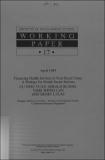| dc.contributor.author | Gu, Xing-Yuan | |
| dc.contributor.author | Bloom, Gerald | |
| dc.contributor.author | Tang, Sheng-Lan | |
| dc.contributor.author | Lucas, Henry | |
| dc.coverage.spatial | China | en_GB |
| dc.date.accessioned | 2014-04-14T17:18:21Z | |
| dc.date.available | 2014-04-14T17:18:21Z | |
| dc.date.issued | 1995 | |
| dc.identifier.citation | Gu, X., G. Bloom, S. Tang & H. Lucas (1995) Financing Health Services in Poor Rural China: A Strategy for Health Sector Reform. IDS Working Paper, 17. Brighton: IDS. | en_GB |
| dc.identifier.uri | https://opendocs.ids.ac.uk/opendocs/handle/20.500.12413/3808 | |
| dc.description.abstract | Since 1950 China has transformed itself from the sick man of Asia' to a country with
better than average health indices for its level of national income. This achievement
was due to a number of factors including a dramatic fall in the prevalence of severe
poverty, improvements in the rural environment, increases in levels of literacy and
the provision of services to meet priority health needs.
The development of the health sector paralleled the establishment of a command
economy organised into state-owned enterprises in the cities and agricultural
collectives, called communes, in the countryside. Its structure reflected this economic
and administrative environment. It was controlled jointly by the Ministry of Public
Health (MoPH) and the Communist Party through a tightly organised hierarchy.
The health services mobilised the population in public health campaigns and
provided almost universal access to preventive programmes and basic curative care.
During the late 1970s the government began to introduce market-oriented reforms
and devolve its financial management. For several years the School of Public Health
of the Shanghai Medical University, in collaboration with the Institute of
Development Studies in England, has been studying the impact of these changes on
rural health services. This paper outlines the problems which health services in poor
rural counties face and proposes a strategy for reform. The major points it makes are
summarised in the box on page 2 and the research findings which led to these
recommendations are presented in the Annex. The aim is to contribute to the
formulation of strategies which ensure that the population of poor rural areas has
access to essential health services. | en_GB |
| dc.language.iso | en | en_GB |
| dc.publisher | IDS | en_GB |
| dc.relation.ispartofseries | IDS working papers;17 | |
| dc.rights.uri | http://www.ids.ac.uk/files/dmfile/IDSOpenDocsStandardTermsOfUse.pdf | en_GB |
| dc.subject | Health | en_GB |
| dc.subject | Poverty | en_GB |
| dc.subject | Rural Development | en_GB |
| dc.title | Financing Health Services in Poor Rural China: A Strategy for Health Sector Reform | en_GB |
| dc.type | IDS Working Paper | en_GB |
| dc.rights.holder | Institute of Development Studies | en_GB |
| dc.identifier.koha | 89036 | |

